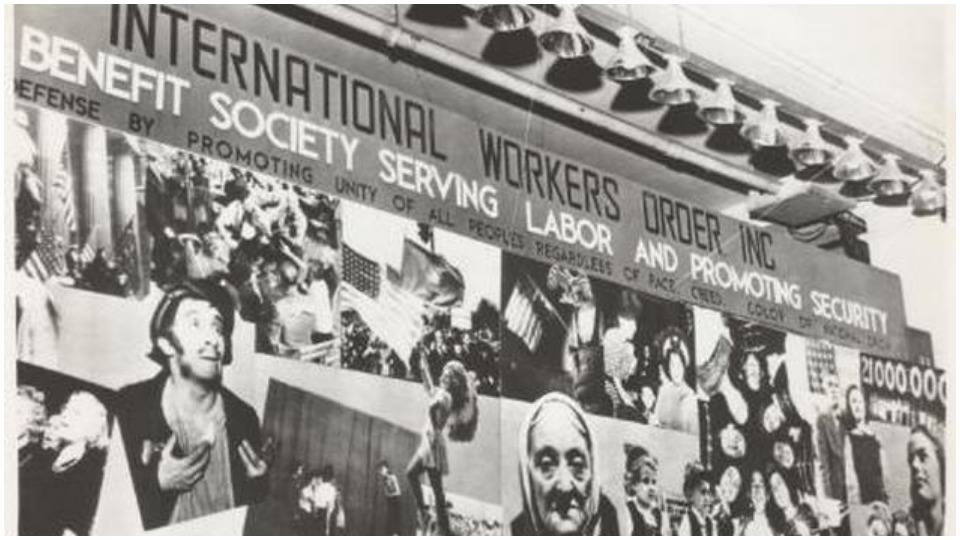
Throughout history, countless mutual-aid societies have been created to help care for the injured and ill, the disabled and their dependents. With the emergence of modern industrial society and its by-product—the masses of workers (native and immigrant) ushered into the factories, mills, and stockyards—it is inevitable that a different type of mutual-aid society would emerge, one that reflected this new social reality.
Add the impact of the birth of the Soviet Union and the growth of the Communist Party USA (CPUSA) to the mix and you get what proved to be, for a short period of time, one of the most important, diverse, and effective communist-led organizations in U.S. history—the International Workers Order (IWO). And what else do you get? An unprecedented assault by the ruling class to dismember and dismantle it.
“The IWO was a consortium of self-insurance fraternal societies with a different, Marxist paternity,” Robert Zecker notes in “A Road To Peace And Freedom”: The International Workers Order And The Struggle For Economic Justice And Civil Rights, 1930-1954.
It was from the Workmen’s Circle, the Jewish People’s Fraternal Order, the Croatian Fraternal Union, the Hungarian Workers’ Sick Benefit and Educational Fund, various Slovak and Russian societies, among others, that the IWO was formed.
Founded in 1930, the IWO was initiated and led by the Communist Party, with a number of prominent communists serving in leadership positions throughout its history. Further, many IWO members saw the CPUSA as “the leading organization of the working class; the brain, the will, and the fighting force of the working class,” and “made a concerted effort” to recruit communists from within the IWO’s ranks, and solicit funds for the Daily Worker, though with mixed results. Anthony Bimba, an organizer with the party’s Lithuanian Bureau, complained that the constant “peddling of all kinds” at IWO meetings was “driving [some] new members away.”
This remained an ongoing challenge throughout the society’s history, as most members joined the Order for the benefits it offered, not necessarily for its radical politics.
Anti-racism was central to the IWO mission. As Zecker writes, “The IWO made a concerted effort to reach out to an interracial constituency, a revolutionary course in the 1930s.” Most other “benefit societies remained racially segregated, and private insurance companies charged African Americans inordinately higher rates for inferior coverage.”
“Unlike commercial carriers and other benefit societies, as early as 1931 the IWO stressed the need to enroll black members in English-language lodges,” leading some African-American members to think of the IWO as “insurance against Jim Crow.”
The IWO also recruited Spanish-speaking workers, Mexican and Puerto Rican, as well as Japanese, Chinese, Brazilian, Greek, and Arab-speakers, among others. A Syrian man in Detroit “wrote the IWO with plans to organize [the Order] among the forty thousand Arabic speakers in his city.” The FBI, in dismay, confirmed his efforts; an Arabic lodge was up and running by December 1945.
The tangible struggle against racism and discrimination was central to the IWO’s mission. Lodges held meetings in members’ native languages: Slovak, Italian, Yiddish, Spanish, Arabic, “and the like,” while also providing health benefits, dental coverage, and payments for disability and accidental death.
Among other benefits designed to empower women, the IWO even organized birth control centers at a time when “disseminating birth control information was still criminalized.” The IWO “was responding to the demands of militant women workers,” Zecker writes. For example, the South Slavic Women’s Educational Club of Cudahy, Wisc., passed a “Resolution on Protection of Motherhood and Childhood.” The resolution stated, in part, “that women never can be socially and economically independent so long as they have to bear continually recurring pregnancies” and called for “reliable and non-injurious birth control information” as well as “maternity homes, vacations before and after childbirth, social insurance, and other measures protecting motherhood and childhood”—a demand just as relevant today as when it was first proposed.
The IWO was a mass organization of about 200,000 members at its peak, and the only group of people not welcomed into its ranks were those “employed as strikebreakers or private detectives [Pinkertons].” It was a ban “unlikely to be allowed by the courts,” but Max Bedacht, the IWO’s general secretary and a communist, found a way away around this legal question. According to Bedacht, “it was permissible ‘to place him [a strikebreaker] on trial…and to fine him a maximum of $99.99,’” then a large sum. As a result, “the organization gets rid of the undesirable person, because these fines are never paid,” while other IWO members are educated “on the principles of the organization,” which were always partisan to the working class.
By the late 1940s, due to its militant activism, the IWO—like other communist-led organizations—was harassed incessantly. It was placed on the Attorney General’s list of so-called subversive organizations and dragged before the House Un-American Activities Committee. State insurance agencies got into the fray, too. Though financially solvent, the IWO was eventually driven out of business in 1954 when the New York State Insurance Department claimed the Order’s political activity was prohibited. Its assets were confiscated, and its members were forced to take out insurance policies with for-profit, private companies—none of whom were committed, of course, to the same egalitarian principles as the IWO.
Robert Zecker has provided a major service in bringing this history to light. “A Road To Peace And Freedom” is highly recommended.
“A Road To Peace And Freedom”: The International Workers Order And The Struggle For Economic Justice And Civil Rights, 1930-1954
By Robert M. Zecker
Temple University Press, 2018, 365pp.












Comments